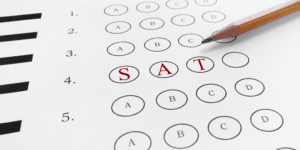In my experience, students either love or hate the Writing & Language section of the SAT. This section has the benefit of being the most overtly consistent from test to test, and students who have a good ear for proper grammar and punctuation tend to instinctively do pretty well on it. Because the section is so consistent, though, students who don’t naturally excel at it do generally see a good jump in their score through practice. So even if the task of comma placement and subject-verb agreement sounds daunting to you, don’t despair. The first step to conquering any section of the test is to know what to expect, so read on for a full SAT Writing & Language overview.
The structure of SAT Writing & Language
Writing & Language is the second section of the SAT and it is composed of 44 multiple-choice questions. These are distributed among 4 passages with 11 questions each. Though the types of passages you see differ from first-person narratives to third-person reports, the variation is not as distinctive as it is on the Reading section. You will find, however, that like the Reading section, two of the Writing & Language passages will contain a figure and ask you one or more questions about it.
What is important to note in any SAT Writing & Language overview is the format in which the questions are presented to you. As you read each passage, you will notice underlined portions of text preceded by a number. Each of these numbers refers to a question, and your goal for the majority of the questions is to decide if you should replace the underlined text, and if so, which answer choice to do that with. Here’s an example:
The SAT (1) is containing a Writing & Language section.
A) NO CHANGE
B) contain
C) contains
D) was contained
If you picked C, you are correct!
Though you will see some variation in the question format (some questions don’t contain an underlined portion of text, whereas others don’t have a “no change” option), the general approach still applies: read the passage, stopping to answer questions when prompted.
The types of questions you’ll see
The most obvious distinction between the question types on the Writing & Language section is whether the question actually asks a question. In my example above, you’ll notice that no question was asked—you were only presented with a set of answer choices. We like to call these answer questions. If you actually have a question being asked, we call it a question question (super creative names, I know). Here’s what you need to know.
- Answer questions make up roughly 2/3 of the section (7-8 of the 11 questions/passage). These questions test the following:
- Punctuation
- Grammar
- Word choice & tone
- Question questions make up roughly 1/3 of the section (3-4 of the 11 questions/passage). These questions test rhetoric (effective writing), which includes the following:
- Combining sentences
- Moving/adding/deleting sentences
- Picking the sentence that best succeeds at getting a certain idea across
The College Board will tell you that questions on this section test things like Expression of Ideas, Command of Evidence, and Standard English Conventions. And while that’s true, I find that focusing on the specifics of what’s being tested (as outlined above) is more useful than the particular skill that you’ll use to answer each question. Because of that, I don’t break down the types of questions more than I just did.
Want more?
If you’d like more help mastering this section and the rest of the SAT, give us a call today!




